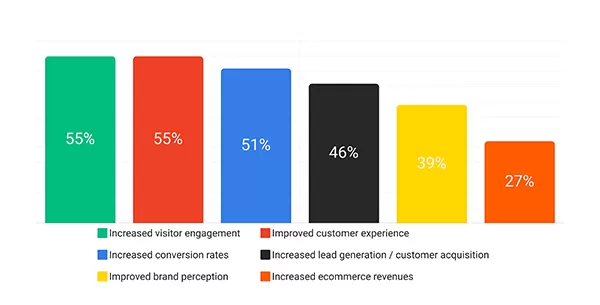The rise of AI machine learning hyper-personalisation has opened doors for marketers to understand consumers better and take the next step in autonomous communication with their customers/prospects.
Predictive AI tools are no longer just focused on analysing data but are now able to predict customer purchasing behaviour. It means that these tools can calculate each individual’s most likely actions, and when they are likely to happen, based on first-party data. With this insight, marketers can now use targeted email marketing to increase response rates and conversions.
How does AI machine learning for email marketing work? What should we expect in future trends? And what components of predictive marketing are critical to success?
Let’s take a deeper look at how it helps you craft the perfect product selection for each customer.
What Is AI Machine Learning Hyper-personalisation And How Does It Affect Email Marketing?
The term hyper-personalisation refers to using customer insights to create personalised content that drives the right customers down the purchase funnel at the right time. It works by analysing customer behaviour, interests, and preferences to provide them with customised product offerings. It enables marketers to enjoy systems that autonomously curate product content, selected individually, to create the perfect email for every subscriber and send it at the most appropriate time, significantly boosting conversions.
This explains the distinction between hyper-personalised email marketing which sends emails based on the past behaviour of customers, and triggered systems which merely wait for an event to happen. Predictive marketers enjoy rich data sets to understand each customer’s unique needs and preferences to enjoy a hyper-personalised unique experience.
Just as targeting the right customers at their known stages in the purchase journey produces better results than traditional mass-email marketing campaigns, so too does the hyper-personalisation of email marketing to obliterate segmentation. For instance, using AI to create granular content for specific demographics is well shy of systems which personalise for every individual consumer that subscribes to your website.
The Main Benefits of Hyper-Personalisation

What Do The Numbers Say?
As reported by MarTechAdvisor, a survey of 579 marketing decision-makers has revealed key insights about the impact of predictive marketing in emails.
According to the results:
- 82% of marketers consider email marketing to be a necessity for keeping up with their competitors.
- 78% of the marketers agree that soon, all marketing will become predictive.
- 81% of marketers are willing to increase their foothold in predictive analytics while driving key marketing decisions.
How Hyper-personalisation Marketing Enhances Emails
Hyper-personalisation can significantly improve the overall email marketing returns while cutting costs. Following are some notable ways in which this is done:
1. Recognising The Interests Of Customers
Hyper-personalisation can simplify the steps of sales nurturing after customers have subscribed to the email list. This makes it easier to execute email marketing:
- Choosing exactly the products an individual is most likely to buy next.
- Utilising the emails being sent to monitor and adjust accordingly based on the net effect.
- Maximising the return from your email investment by not requiring any staff to operate it.
Since hyper-personalisation and individualisation can help to identify customer needs, it becomes easier to pinpoint products most relevant to each customer, the natural effect of being able to capture sales instantly from the data enables the retailers to substantially increase the marketing ROI.
2. Using Dynamic Content Based On Customer Behaviour And Preferences
Using real-time data and AI allows marketers to understand their subscribers and serve them specific content that speaks to their needs and interests instantly (in nano-seconds) – not just what they’ve done in the past. This results in better open rates, higher click-through rates, and more conversions.
By identifying how customers are most likely to respond to emails, as well as what type of content they’re most interested in, you can provide highly targeted email marketing services that will produce better engagement.
Using real-time feedback and AI makes email marketing more dynamic and personal – resulting in a positive impact on your business’s bottom line.
3. Using Recipient Data To Ensure Higher Deliverability Rates For Their Emails
By identifying key factors that impact email deliverability, such as IP address blacklists, marketers can ensure greater success when it comes to email reach. Systems such as SwiftERM use Sendgrid to ensure perfect deliverability and adjust your DNS to ensure all systems to avoid blacklisting is employed.
4. Hyper-personalising Email Content To Real-Time Intent
With AI machine learning hyperpersonalisation, each email is autonomously updated for each subscriber’s current stage in the buying process. This helps to provide the maximum relevancy of content instead of sending generic messages that may lack context.
5. Identifying Risk Indicators Against Churn
Predictive marketing leverages AI to identify red flags in subscriber behaviour that demonstrate the threat of churn. This allows the system to act quickly and save your customer relationships before they ever leave!
6. Building Better Omnichannel Experiences
contentPredictive analytics allows marketers to look at all interactions that a user has with any touchpoint and understand what is relevant when it’s relevant to them. This helps you deliver a personalised experience throughout the entire lifetime of the customer.
In addition, because your customer data is always up-to-date, smarter decisions are made for you – such as knowing when it’s the best time to cross-sell or upsell with the right emails.
So, before making any big decisions around marketing campaigns, you can leverage predictions to ensure that you’re making data-driven decisions and setting yourself up for success.
Key Use Cases Of Hyper-personalised Marketing In Email
Let’s look at some key examples of how predictive marketing fits into the email marketing universe and what the results look like:
- Predicting the interest of a prospective customer in a specific email content.
- Selecting and sharing relevant products for customers based on their likelihood to buy.
- Detecting the signs of dissatisfaction among customers and preventing the likelihood of churn with relevant engagement.
- Recommending the best combination of products to customers to increase their cart values.
- Predicting the likelihood of a new customer to convert into a loyal customer and using the right incentives to do so.
It is important to see what happens in real-time with many retailers, they get duped into believing segmentation is personalisation. Because lumping a load of people in a category together does not work. It is not personal it is just a smaller group of diverse tastes and interests. This is the equivalent of you sending an email to everyone who bought a red item, or an XL size, which is painful when you measure the effect.
Beware of the distinctions between hyper-personalisation software providers, they vary considerably. It uses data captured from each consumer as they visit your site, including what they look at, return to most often, etc. It then aligns this with both that individual’s buying history and their perpetual purchases, to rank every SKU on your site by the greatest likelihood of imminent purchase. Instead of waiting to convince that person to buy a specific product, (this season’s stock for example) it uses a predictive analytics machine learning algorithm to work out what has been achieved already, and simply capitalise on it.
Thanks to hyper-personalisation in email marketing, marketers no longer have to sift through copious amounts of customer data to make key customer engagement decisions. Such data-heavy approaches have given marketers today the opportunity to pinpoint customers’ needs at ‘quantumesque’ levels, making the future of email marketing brighter than ever!





